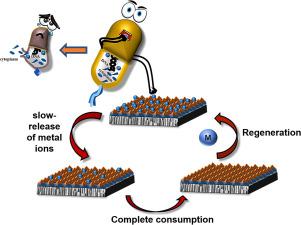Desalination ( IF 8.3 ) Pub Date : 2022-02-28 , DOI: 10.1016/j.desal.2022.115655 Xinjian Tang 1 , Wenxiu Hu 1 , Xiaoxue Ke 2 , Yuming Zheng 2 , Qingchun Ge 1

|
The current Covid-19 aggravates membrane biofouling issue caused by bacteria and viruses which are widely present in water. Herein we synthesized a series of polyamide (PA)-based membranes engineered with distinct metal ions (Cu2+, Fe3+) via one-step metal-ligand ligation for forward osmosis (FO) separation. The antibacterial and desalting behavior of membrane were investigated by systematically varying the influential factors including the charge status, complexation ability and antibacterial mechanism of metal ions as well as testing conditions. All the newly synthesized membranes exhibit better performance with markedly increased water permeability and selectivity. Therein the Fe3+ − membrane increases water fluxes by 93% (FO mode) and 112% (PRO mode) relative to the nascent PA membrane with 0.5 M NaCl as the draw solution. Both Cu2+ and Fe3+ on membrane surface dramatically improve the membrane bactericidal efficacy against Escherichia coli via destroying the bacterial phospholipid layer. Remarkably, the metal ions on membrane surface are easily regenerated after being consumed by bacteria by simply immersing the membranes into the corresponding nitrate solutions. The separation performance and antibacterial properties of the regenerated membranes are comparable to those of the fresh membranes. When using brine from reverse osmosis process as the draw solution, the Fe3+ membrane recovers water from brackish water up to 70% higher than the nascent PA membrane. This study provides a practical strategy to develop FO membrane with sustainable antibacterial activity and desalination performance.
中文翻译:

金属离子工程正向渗透膜的抑菌脱盐行为
当前的 Covid-19 加剧了由广泛存在于水中的细菌和病毒引起的膜生物污染问题。在此,我们合成了一系列基于聚酰胺 (PA) 的膜,这些膜通过一步金属配体连接用于正向渗透 (FO) 分离而设计有不同的金属离子 (Cu 2+、Fe 3+ )。通过系统地改变金属离子的电荷状态、络合能力、抑菌机理以及测试条件等影响因素,研究了膜的抑菌和脱盐行为。所有新合成的膜都表现出更好的性能,显着提高了透水性和选择性。其中Fe 3+ − 与使用 0.5 M NaCl 作为汲取溶液的新生 PA 膜相比,膜将水通量增加 93%(FO 模式)和 112%(PRO 模式)。膜表面的Cu 2+和Fe 3+均通过破坏细菌磷脂层显着提高了膜对大肠杆菌的杀菌效果。值得注意的是,膜表面的金属离子在被细菌消耗后很容易再生,只需将膜浸入相应的硝酸盐溶液中即可。再生膜的分离性能和抗菌性能与新鲜膜相当。当使用来自反渗透工艺的盐水作为汲取溶液时,Fe 3+膜从微咸水中回收的水比新生的 PA 膜高 70%。本研究为开发具有可持续抗菌活性和脱盐性能的 FO 膜提供了实用策略。











































 京公网安备 11010802027423号
京公网安备 11010802027423号